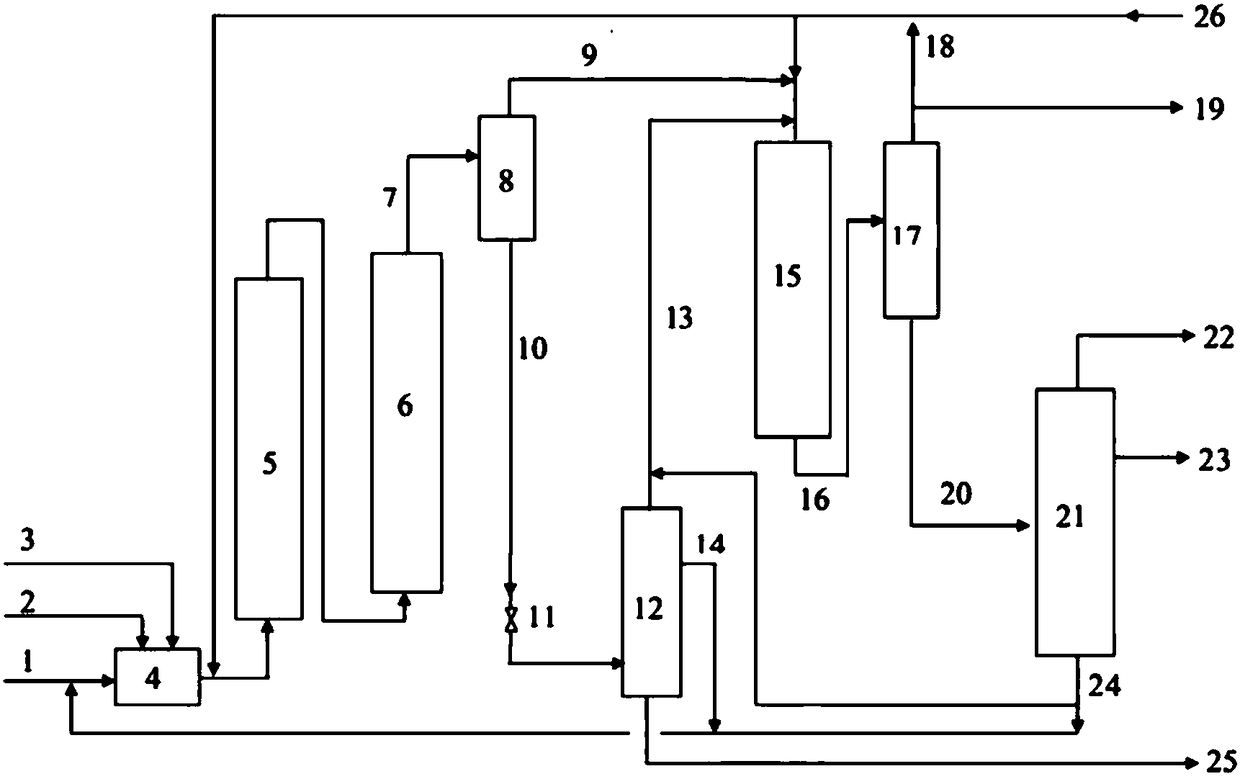Method for producing light oil from biomass through liquefaction
A biomass and light oil technology, which is applied in the preparation of liquid hydrocarbon mixtures, the treatment of hydrocarbon oil, and the petroleum industry. Effects of clogging, volume reduction, and porosity reduction
- Summary
- Abstract
- Description
- Claims
- Application Information
AI Technical Summary
Problems solved by technology
Method used
Image
Examples
Embodiment 1
[0062] This embodiment provides a method for biomass liquefaction to produce light oil, such as figure 1 shown, including the following steps:
[0063] (1) Send rapeseed oil residue and olive oil residue into a drier and dry at 80°C for 3 hours until the water content is lower than 2wt%, and then send them into an ultrafine pulverizer for primary crushing. The median particle size after primary crushing is 100μm, and then send the primary pulverized rapeseed oil residue and olive oil residue into a plodder for compression extrusion molding at a temperature of 50°C and a pressure of 3MPa, and then carry out secondary crushing treatment, and after secondary crushing, medium Mixed particles 2 of rapeseed oil residue and olive oil residue with a particle size of 30 μm, and the bulk density of the mixed particles 2 is 1500 kg / m 3 ;
[0064] Mix the above mixed particles 2, amorphous alumina 3 loaded with Mo oxide and Ni oxide (the particle size is 5 μm-50 μm, and the loading capa...
Embodiment 2
[0075] This embodiment provides a method for producing light oil from biomass liquefaction, comprising the following steps:
[0076] (1) Put palm oil residue and castor oil residue into the drier and dry at 100°C for 2h to a water content lower than 2wt%, then send them into an ultrafine pulverizer for initial crushing, and the median particle size after the initial crushing is 300μm, and then the palm oil residue and castor oil residue after the initial crushing are sent to the plodder for compression extrusion molding at a temperature of 60°C and a pressure of 5MPa, and then secondary crushing is carried out, and medium A mixed particle 2 of palm oil residue and castor oil residue with a particle size of 50 μm, the bulk density of the mixed particle 2 is 1600kg / m 3 ;
[0077] The above mixed particles 2, amorphous alumina 3 loaded with W oxide and Pd oxide (with a particle size of 100 μm-150 μm, and a loading capacity of 25%) and carbon disulfide 1 were produced in a mass r...
Embodiment 3
[0088] This embodiment provides a method for producing light oil from biomass liquefaction, comprising the following steps:
[0089] (1) Send the saponin oil residue into the drier and dry at 110°C for 6h until the water content is lower than 2wt%, then send it into the ultrafine pulverizer for primary pulverization, the median particle size after the primary pulverization is 200 μm, and then Send the saponin oil residue after primary crushing into a plodder for compression extrusion molding at a temperature of 40°C and a pressure of 4 MPa, and then carry out secondary crushing, and after secondary crushing, obtain a product with a median particle size of 40 μm. Saponin oil residue granule 2, the bulk density of this granule 2 is 1550kg / m 3 ;
[0090] The above particles 2, amorphous alumina loaded with Mn oxide (the particle size is 100 μm-150 μm, and the loading capacity is 15%), amorphous iron oxide and sulfur in a mass ratio of 100:2:2:0.3 Mix the mixture in the substanc...
PUM
| Property | Measurement | Unit |
|---|---|---|
| Bulk density | aaaaa | aaaaa |
| Viscosity | aaaaa | aaaaa |
| Particle size | aaaaa | aaaaa |
Abstract
Description
Claims
Application Information
 Login to View More
Login to View More - R&D
- Intellectual Property
- Life Sciences
- Materials
- Tech Scout
- Unparalleled Data Quality
- Higher Quality Content
- 60% Fewer Hallucinations
Browse by: Latest US Patents, China's latest patents, Technical Efficacy Thesaurus, Application Domain, Technology Topic, Popular Technical Reports.
© 2025 PatSnap. All rights reserved.Legal|Privacy policy|Modern Slavery Act Transparency Statement|Sitemap|About US| Contact US: help@patsnap.com

